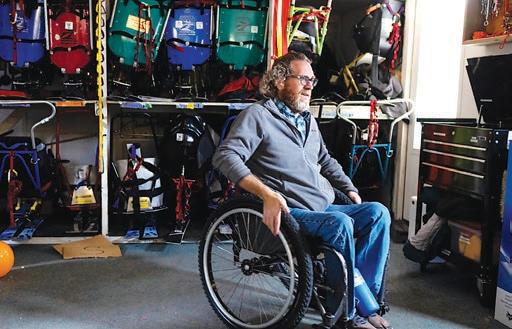
4 minute read
LIFEGUARDS
South Suburban Parks and Recreation District (SSPRD), which reported a signi cant shortage of lifeguards earlier in the month, received $10,700 — the highestallocated amount awarded to more than a dozen districts or cities. Cities like Aurora and Boulder received the same amount.
Part of the shortage lies with the expensive cost of training lifeguards. Many prospective employees may be dissuaded by the idea of paying to obtain lifeguard certi cation. ough it won’t solve the main shortage problem, having the funding helps, said SSPRD Aquatics Manager Karl Brehm, who came down from a lifeguard stand himself to talk to Colorado Community Media.
“It will help us reach a demo- state 70, adaptive-compliant hotels and adaptive sports programs. With increased access to adaptive adventure and adaptive adventure travel improved, some of the onceinsurmountable-seeming barriers to rolling up to a resort and shredding have been lowered. ank goodness they and many other resorts comp tickets because otherwise a lot of these programs graphic that is lacking in having the funds upfront to start,” Brehm said.
As for the high cost of tearing down the slopes in search of a goggle tan, “that’s a barrier for anybody wanting to go skiing,” Werhane adds. Adaptive equipment — for things like sit skis and outriggers — can cost thousands of dollars. Many adaptive snow sports programs are non-pro t, so they rely on fundraising, donations and in-kind gifts to stay running.
“But look at Breck’s adaptive program,” Werhane says. “For $165 a day you get a lift ticket, an instructor and the ability to ski on a $6,000 piece of equipment the Breck adaptive center bought. Breck probably isn’t going to get their money back on that purchase in one to two years.
“With the grant, we will defer the payment of those [lifeguard] certication costs.” wouldn’t exist.” ousands of Colorado’s adaptive ski instructors are volunteers, so paying them isn’t a problem; many resorts will donate day or season passes to them. Nickell says Ignite’s roughly 250 instructors all volunteer. In the 2019-20 season, 244 gave 1,085 lessons to 285 students, amounting to 14,253 hours of volunteer time at a value of $399,365.
A full-course lifeguard training at South Suburban through Red Cross costs $175. Community First Aid, CPR and AED training/blended learning costs $80. But after 75 hours of work, South Suburban reimburses course fees [excluding the $40 certi cation fee].
Other communities received smaller amounts. e City of ornton got $6,892, Commerce City, $1,462, and Parker, $4,499. e Town of Castle Rock received $7,873 and Brighton received $1,687.
A national lifeguard shortage affects roughly a third of public pools throughout the country. Colorado has struggled similarly. e state grant money aims to help train and retain lifeguards, which can be difcult to do these days, according to Brehm.
“We do what we do really well,” Nickell says.
But Erik Weihenmayer, the blind adventurer who has climbed Mount Everest, kayaked the Grand Canyon and skied the Haute Route from Chamonix to Zermatt with guides, says not all volunteer instructors are equal either in guiding ability or sensitivity to their students.
“I like some programs, but the problem with others is that you show up and you don’t know who your guide is,” he says. “I can’t speak to other disabilities, but as a blind person, it’s about creating relationship, trust and communication. You can’t snap your ngers and do that in ve minutes. You have to have consistency. You’re listening to the person guiding you. You’re learning to read each other’s minds so when your guide says turn left you know exactly what they mean by that. If you don’t have consistency, if there’s a new guide every time you go skiing, then it’s a problem and a lot of organizations fall short in that way.”
He also takes issue with the prices he says some adaptive programs charge: “I went to Vail one time and they were gonna charge me $500 — over $200 for me and $200 for my guide. I go, ‘Wait, my guide is my eyes, folks. He should be free. He’s simply here to guide me down the mountain. I can’t see and you’re gonna charge me double?’”
Weihenmayer is a high-level skier, so a program like Foresight Adventure Guides for the Blind works better for him anyway.
“I like them because I can call e funds from the state help provide time for pools to keep hiring and training ongoing, Brehm added. them up and they’ll pair me with the right person who guides me from behind,” he says. “Most blind guides guide from the front, but guiding from behind is better, because as a sighted person what do they tell you to do? Look down the fall line. ey don’t tell you to lean your head back to try to listen to a guy behind you. If your guide is in front of you, the sound comes back and you ski into it.” With the right guide and using this method, Weihenmayer says he skis aggressively, with good form, and makes “nice, round turns.”
“I have seen, more and more, less interest in the position,” Brehm told Colorado Community Media in May.

Brehm said South Suburban, like many other area pools, must hire throughout the season to try and maintain strong employee numbers.
Programs like Ignite, Telluride Adaptive Sports and 30-year-old Crested Butte Adaptive Sports Center, which annually attracts around 800 people with physical and developmental disabilities, have improved their facilities, increased their o erings and given their instructors the opportunity to train with the Professional Ski Instructors Association. Crested Butte adaptive went over and above in 2019, when it constructed the massive ski-in, ski-out Kelsey Wright Building in the resort’s base area with funds raised in a capital campaign. eir center also o ers veterans, active military and rst responders with disabilities — and their families — $50 fullday lessons for summer and winter activities. e special rate extends to veterans, active military and rst responders who have a family member or child with a disability.
So what do resorts get for supporting adaptive programs?
Jessica Conyers, a therapist who works for the Veterans Administration at the Valor Point Domiciliary in Lakewood and helps coordinate the largest rehabilitative ski and snowboard program in the U.S., the annual National Disabled Winter Sports Clinic for Veterans, says for over a week every March, veterans from across the country descend on Snowmass to try adaptive skiing or snowboarding for the rst time or to continue their adaptive journey.
He described the support as not a favor, however, but a public service. “It hearkens to a safety situation. People want to have the pools open. We want to have them open. But there’s a barrier that stands there,” Brehm said in response to the funding. “Having the state recognize that it is something that people want, and there’s a barrier to it, I look at it as a civic responsibility. ere is a need, and it is being met.”









